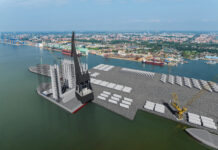
Busan Port Authority (BPA), aware of the challenges facing liner operators, could offer volume-linked rental rates to terminal operators from 2022, ahead of the opening of the opening of Phases 2-5 and 2-4 of Busan New Port (BNP).
Currently, a fixed rent is paid based on the area of the wharf, regardless of the amount of loading and unloading.
The volume-linked rental system could reduce the terminal operators’ financial burdens and discourage them from engaging in a price war by cutting fees.
The restructuring of the rental system is being explored by a working group comprising BPA, the Ministry of Oceans and Fisheries and Korea Maritime Institute.
Phase 2-5 is situated on the western side of BNP and is scheduled to open in July 2020; in May 2022, Phase 2-4, situated on the southern part of the port, will open.
Phase 2-4 is being contracted to Busan Container Terminal Company, which is owned by South Korean conglomerate CJ Logistics and Hong Kong group Hutchison.
In total, the six berths of Phase 2-5 and Phase 2-4 can handle 3.9 million TEU annually, and there is concern among liner operators over fierce competition between terminal operators. Particularly, Korea Shipping Partnership (KSP) will operate the berths under Phase 2-5 and Phase 2-6, which will also be ready in 2022.
KSP is a quasi-alliance of 14 South Korean intra-Asia-focused liner operators, including HMM, SM Line, Taiyoung Shipping, Korea Marine Transport Company, and Dongjin Shipping.
Currently, five other terminal operating companies and liner operators are running terminals in BNP, processing 15 million TEU annually. These include DP World, PSA International, HMM, Ocean Alliance, THE Alliance, 2M and Macquarie Korea Infrastructure Fund.
Phases 2-4 and 2-5 were planned on forecasts that Busan’s annual container volumes would grow by 3%-4%, but growth was just 1% in 2019, with throughput of 21.7 million TEU.
This year, the Covid-19 pandemic is expected to result in volume contractions, amid disruptions to shipping demand that has seen liner operators cutting sailings.
Martina Li
Asia Correspondent





